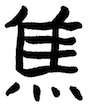  
Learning kanji involves lots and lots of writing by hand. I haven’t been in the habit of doing a lot of handwriting in, oh, thirty years–not since I convinced my elementary school teachers to let me hand in typed homework. And typing in Japanese is extremely simple (and fun) on any modern computer or smartphone or iPad.
But kanji can really only be learned by hand. (Actually, it can probably be learned by writing it with your finger on a touchscreen, but I’m too old for that to feel natural.) Right now I’m almost exactly one-third of the way through learning to write, from memory, the 2,100 “daily” kanji literate Japanese are expected to know. Perhaps it’s an exaggeration to say I’m one-third done, since at any given time I’ve forgotten about 20% of them, but at least I keep remembering 80% of a larger number.
In a couple of days I’ll share some of the agonies involved in writing kanji, but today I want to talk about the pleasures: the gear.
Because I spend an hour a day writing kanji, I wanted a good pencil and a good pen: a pencil because I make loads of mistakes that I want to erase, and a pen because modern kanji is very much in touch with its calligraphic roots, and sometimes it’s just more fun to write it with the proper pen. (As Alex Kerr notes in his book [Lost Japan](http://www.amazon.com/dp/1741795230/?tag=mamstesgrubshack), doing Japanese calligraphy is a lot more fun if you have a drink in front of you.)
When I went to my local Kinokuniya branch to shop for writing implements, I found myself in a classic [paradox of choice](http://en.wikipedia.org/wiki/Paradox_of_choice) situation, faced with over a hundred mechanical pencils to choose from before I even stepped into the pen section. It was exactly like in the book _Millions of Cats:_ each of the millions and billions and trillions of pencils seemed to be the prettiest. Do I choose based on lead thickness? Ergonomic gel grip? Cartoon mascot?
I bought a $3 pencil (because it was purple) and went home to do more research by visiting [JetPens.com](http://jetpens.com), which specializes in Japanese pens and pencils. That’s where I discovered Kuru Toga, the very definition of an obscure modern convenience you didn’t know you needed.
[Kuru Toga](http://www.jetpens.com/Uni-ball-Kuru-Toga-Auto-Lead-Rotation-Mechanical-Pencil-0.3-mm-Black-Body/pd/3215) is a spring-loaded gearworks that slowly rotates your pencil lead while you write. Follow the link and you’ll see a very Japanese comic explaining why you would want this. In short: you get a more consistent line and less lead breakage. It really works, and more important, you can see it working through a clear plastic window in the pencil. It’s not even that expensive: the model I linked to is the one I bought, for less than $10.
For when I’m in a swoopy calligraphic mood, I picked up a [brush pen](http://www.jetpens.com/Brush-Pens/ct/221), another item I never knew existed until I went looking for it. It’s just what it sounds like: an ordinary-looking pen with a paintbrush tip.
There are three or four different types of strokes used for writing kanji. When you write with a pencil, you can be pretty lax about using the right kind of stroke and no one but the most fastidious Japanese language teacher will ever know. With a brush pen, there is no room for error. This is frustrating but also fun. The pen I bought, which was less than $5, has a brush on each end: one large, one small. (The caps nest, so you can pull the cap off either end and stick it onto the other end while you’re writing.)
Those kanji at the top of the post are a few I wrote with my brush pen. Feel free to make fun of them.
